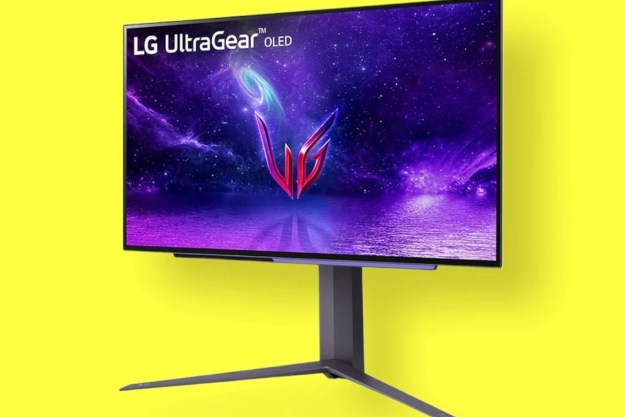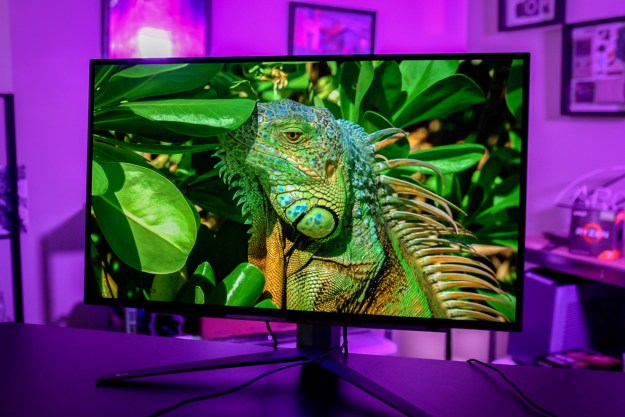
“Even with some OLED concerns, the UltraGear OLED 27 ticks all the boxes for a high-end gaming display.”
- Vibrant colors and HDR
- Excellent motion clarity
- Fantastic matte finish
- Generous port selection
- Sturdy stand with plenty of adjustments
- Low SDR brightness
- Some text clarity issues
- Remote is necessary to control the display
For years, the best gaming monitors have leaned on one type of panel: traditional LCD. But that’s starting to change, and LG is leading the charge. The UltraGear OLED 27 (27GR95QE-B) is the first 27-inch OLED gaming monitor, finally offering the vibrant HDR, true blacks, and astounding motion clarity of OLED in a monitor form factor that makes sense. And it delivers on all fronts.
There are some issues, most notably the cumbersome remote and high price for a 1440p display, but those immediately fade into the background when the UltraGear OLED 27 comes to life. Perfect pixel density meets vibrant colors meets a high refresh rate capable of excellent motion clarity, adding up to a display that’s not only one of the best gaming
Video review
LG UltraGear OLED 27 (27GR95QE-B) specs
| LG UltraGear OLED 27 (27GR95QE-B) | |
| Screen size | 27 inches |
| Panel type | OLED |
| Resolution | 2,560 x 1,440 |
| Peak brightness | 200 nits (SDR), 800 nits (HDR) |
| HDR | Yes |
| Local dimming | N/A – OLED |
| Contrast ratio | 1,500,000:1 |
| Response time | 0.03 milliseconds (GtG) |
| Refresh rate | 240Hz |
| Curve | None |
| Speakers | None |
| Inputs | 2x HDMI 2.1, 1x DisplayPort |
| Ports | 2x USB 3, 1x 4-pole headphone/microphone |
| Adjustments | 4..3 inches height, 20 degrees swivel, 20 degrees tilt |
| List price | $1,000 |
| Where to buy |
Striking design, half-baked execution
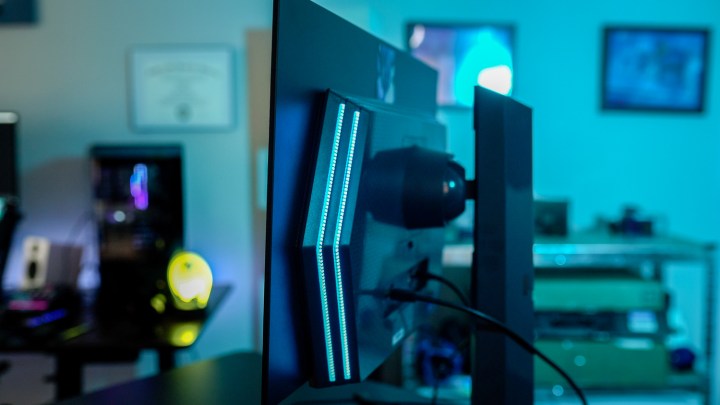
The first thing that stands out about the UltraGear OLED 27 is how thin it is. There’s a chunky back panel that houses the connection ports and active (but silent) cooling, but the panel itself is only a fraction-of-an-inch thick.
On the back, there’s some bright LED lighting that you can set to one of our static colors or cycle through a spectrum. The color matches a smaller underglow light that shines down through the control button. Yes, that’s just a single button to control the monitor, which is where the UltraGear OLED 27 starts to run into problems.
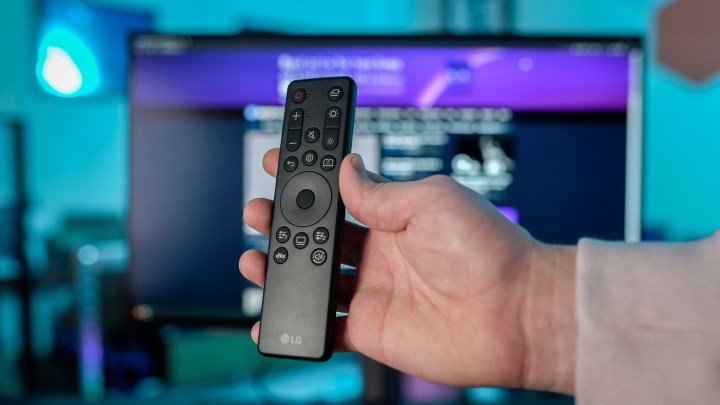
I’m a big fan of LG’s on-screen display (read my UltraGear OLED 48 review for more on that), but it’s just a pain to access on the OLED 27. The singular control button doesn’t let you access the full menu, instead asking you to do a single press to cycle through a quick access menu or a long press to select a setting. This leads to situations where turning down the brightness requires pressing the button 100 times to go from the brightest settings to the dimmest.
You’re meant to control the monitor with the included remote, but even with that, the UltraGear OLED 27 runs into issues. For starters, the battery slot on the remote requires a screwdriver to get open, and LG doesn’t include the coin battery you need to power the remote. This wouldn’t be a problem if you could control the on-screen display with the button on the monitor, or if LG had included the battery, which very few people are likely to have laying around, but neither of those things are true.
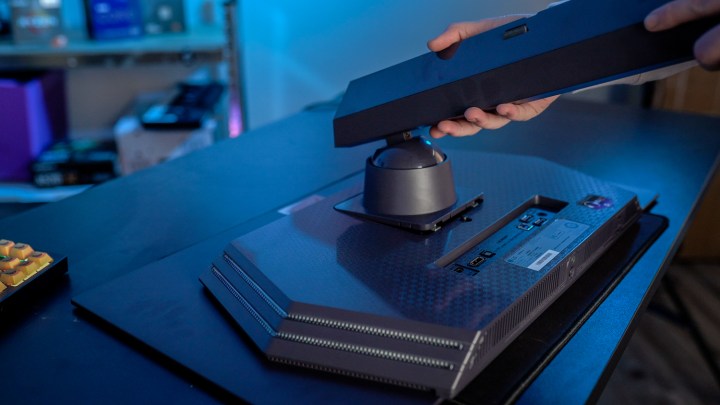
That’s annoying, but it’s an easy problem to solve. What the UltraGear OLED 27 gets right is adjustment. Ironically, you don’t need a screwdriver to set up the sturdy stand, and it enables just shy of four-and-a-half inches of height adjustment, 20 degrees of swivel, 20 degrees of tilt, and the ability to turn the monitor vertically.
It also has great port selection. You get two USB 3.0 passthroughs on the back, as well as a headphone/microphone jack on the bottom of the display. This port even supports DTS Headphone:X for virtual 3D audio, offering a high-end audio experience right under the front of the display.
Beautiful, vibrant OLED

What makes the UltraGear OLED 27 special is right in the name: OLED. Self-dimming pixels mean you get true black levels and a theoretically infinite contrast ratio. It’s the antidote for the embarrassing state of HDR with most gaming
Brightness isn’t the main draw here, though. It’s contrast. LG claims the monitor can reach peak brightness of 1,000 nits, but only for 3% of the screen. I measured a max brightness of 600 nits, but that was with
It’s not as bright in

And that color is vibrant. I measured 100% coverage of the sRGB color space, as well as 97% coverage of DCI-P3. Color accuracy was excellent out of the box, too, with a color error of 1.5 (less than 2 is ideal for video and photo editing). You could easily jump in and start editing a video on the UltraGear OLED 27 without any adjustments to the color.
That’s only in SDR, though.
I measured a color error of above 6 in
OLED doesn’t come free on concerns, either. Burn-in is an omnipresent issue, as static elements will fade into the display over time. LG includes some features like an automatic screen saver and pixel shifting, and burn-in is less of an issue on OLED today than it was in years past. But it’s still a relevant concern to bring up if you plan on using the UltraGear OLED 27 for daily use outside of gaming.
Perfect pixel density
I was a little taken back when I heard the LG OLED 27 was a 1440p monitor. It’s $1,000, which is tough to swallow when even premium
At 27 inches, the pixel density is excellent on the UltraGear OLED 27. Text looks super sharp, and images look vibrant thanks to the OLED panel. You’re spending more for fewer pixels, but that’s not really important once you sit down and look at the monitor.
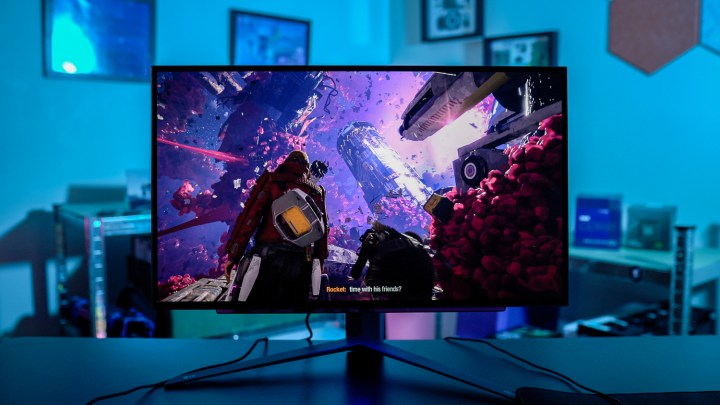
It’s not a crazy price, either. Alienware’s 34 QD-OLED is anywhere from $1,100 to $1,300. It has a higher resolution, but only because it uses an ultrawide 21:9 aspect ratio. The UltraGear OLED 27 is basically that same monitor pixel-wise, just with the ultrawide wings cut off.
But I mainly appreciate the resolution because of the refresh rate. This is a 240Hz panel, and while it’s hard to recommend such a high refresh rate on a
Given how great the OLED panel looks, the UltraGear OLED 27 makes a very strong argument that more resolution isn’t always better. And paired with the high refresh rate, it looks fantastic.
The only concern for text clarity is the WRGB subpixel structure, which is an issue we saw on the first batch of QD-OLED
Superb gaming

You should already know the UltraGear OLED 27 is a great gaming monitor. A 240Hz refresh rate, response times below 0.1 millisecond, FreeSync certification and G-Sync support, and stunning
It’s that combination that makes the UltraGear OLED 27 so striking. The 240Hz refresh rate is easily beaten out by the recent barrage of 360Hz screens we’ve seen, like the Asus PG27AQN, but it’s still much higher than you see on a typical gaming monitor. Combined with the response time, motion clarity can reach the levels of a 360Hz panel, making it a great option for competitive games like Overwatch 2, Rainbow Six Siege, and Valorant.
The UltraGear OLED 27 has competitive games down, but it also has cinematic games nailed. OLED and the stellar
And that’s the problem most gaming
Should you buy the LG UltraGear OLED 27?

I’ve never encountered a monitor that makes perfect sense like the UltraGear OLED 27 does. It doesn’t always hold up on the spec sheet, but sitting down in front of the monitor consistently reinforced one idea: this is one of the best gaming experiences you can have right now.
It isn’t perfect, particularly for desktop use where OLED burn-in and text clarity are more pressing issues, but those problems are easy to overlook. What you’re getting is excellent motion clarity, response time,
The main competition it has is the Alienware 34 QD-OLED, which says a lot about how excellent the UltraGear OLED 27 really is. LG’s advantage here is a slightly lower price and much higher refresh rate, finally bringing competitive and cinematic gaming experiences in balance.
Editors' Recommendations
- MSI and Asus just flipped the script for their OLED gaming monitors
- MSI has some massive QD-OLED monitor news in the works
- Samsung Odyssey OLED 49 vs. Odyssey Neo G9 (2023)
- I saw LG’s 27-inch OLED, and it felt like the future of gaming monitors
- We finally know the price of LG’s 240Hz OLED gaming monitors




